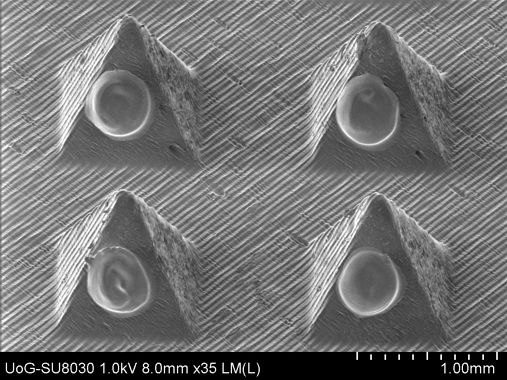An Animal Study for Insulin Delivery by Microneedles:
Microneedle arrays are miniature puncturing devices that disrupt the skin barrier to deliver therapeutic agents trans dermally, in a pain free manner. Common drawbacks associated with typical microneedle coating techniques such as dip-coating, suffer from poor controllability of the outcome in terms of coating morphology, spatial deposition and amount of the drug loaded.
Customers at Greenwich University, UK, uses the GeSiM Nano-Plotter NP2.1 to develop and implement an advanced microneedle coating protocol that achieves uniform, tailored drug deposition. The process forms drug-containing films of micrometre thickness with exceptional repeatability of the drug loading, with no satellite droplets on the microneedle substrate that would imply drug losses. Extensive studies on the application of the protocol to coat metallic and 3D printed polymeric microneedles with insulin and anticancer agents have generated very promising results in vivo. Porcine skin was used for drug delivery and distribution experiments.

Pyramidal microneedles with piezo-spotted drops. The needle array was arranged at 45° on the Nano-Plotter.
![An Animal Study for Insulin Delivery by Microneedles 2 Insulin release vs. time for porcine skin [3]](https://gesim-bioinstruments-microfluidics.com/wp-content/uploads/2020/05/Insulin-release-through-microneedle.png)
Insulin release vs. time for porcine skin [3]
Courtesy of: Dr Sophia Economidou & Prof Dennis Douroumis, University of Greenwich, Faculty of Engineering and Science, UK
Relevant publications:
- Uddin MJ, Scoutaris N, Klepetsanis P, Chowdhry B, Prausnitz MR, Douroumis D. Inkjet printing of transdermal microneedles for the delivery of anticancer agents. Int J Pharm [Internet]. 2015;494(2):593–602.
- Ross S, Scoutaris N, Lamprou D, Mallinson D, Douroumis D. Inkjet printing of insulin microneedles for transdermal delivery. Drug Deliv Transl Res. 2015;5:451–61.
- Pere CPP, Economidou SN, Lall G, Ziraud C, Boateng JS, Alexander BD, et al. 3D printed microneedles for insulin skin delivery. Int J Pharm [Internet]. 2018;544(2):425–32.
- Economidou SN, Pere CPP, Reid A, Uddin MJ, Windmill JFC, Lamprou DA, et al. 3D printed microneedle patches using stereolithography (SLA)for intradermal insulin delivery. Mater Sci Eng C. 2019;102(October 2018):743–55.
- Uddin MJ, Scoutaris N, Economidou SN, Giraud C, Chowdhry BZ, Donnelly RF, et al. 3D printed microneedles for anticancer therapy of skin tumours. Mater Sci Eng C. 2020;107(October 2019):110248.

